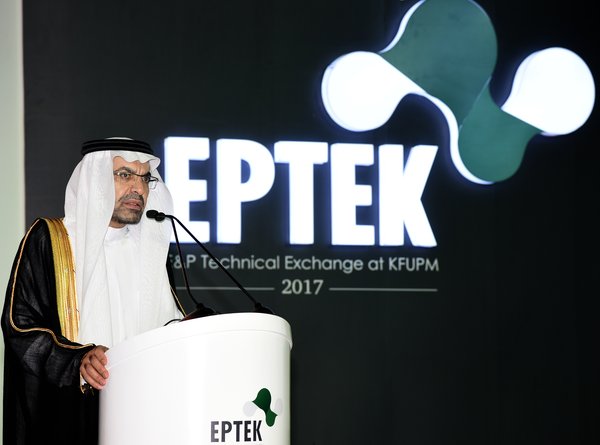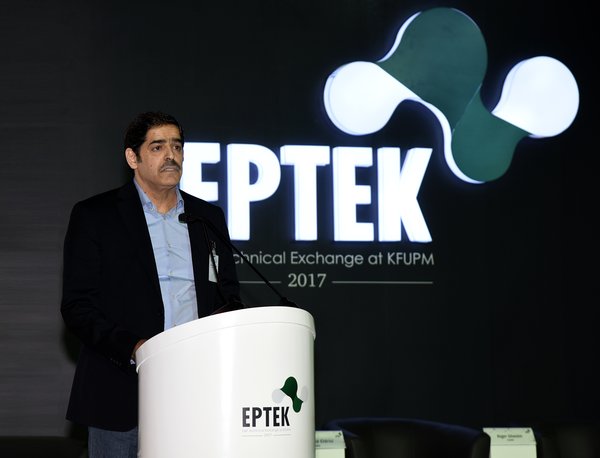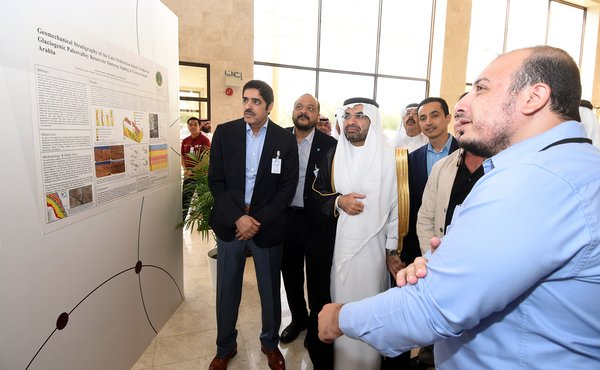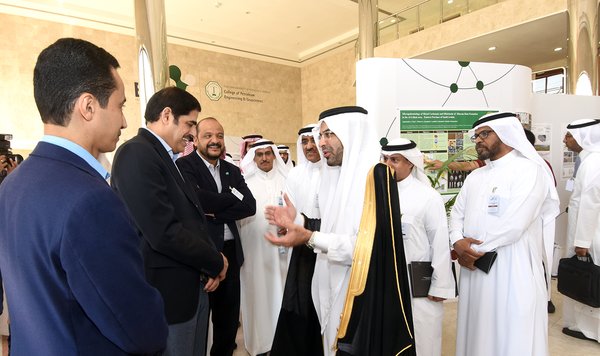The Development of Oil Production Techniques Symposium Discusses Solutions to Enhance Energy Resources and the Challenges of Increasing Demand
Oct. 26, 2017 | Campus
Beyond current practices, discuss new methods and innovative technologies to solve the problems of exploration and production.
- Enhance communication between E & P (exploration and production) techniques with nanotechnology, biochemistry, artificial intelligence, astrophysics, and aerospace science.
Monitor major challenges in E & P and discuss solutions provided by other disciplines.
Dr. Khaled Al-Sultan:
The partnership with Aramco starts with the founding of KFUPM and we worked together to promote E & P research.
- The rapid development of the College of Petroleum Engineering witnessed the success of the partnership between KFUPM and Saudi Aramco.
The proximity of the College to the largest oil producer in the world, allows for the potential of attracting international cadres and developing a partnership with global research centers, which will provide with opportunities for success.
- Developing partnerships with industry and promoting world-class student research will result in the success of the research center.
The College is establishing the Applied Research building, the Oil and Gas Entrepreneurship Center, demonstration laboratories and promoting professional training in the Dhahran Valley.
Engineer Nasser Al Naimi:
The University is a pioneer and its contribution in the field of energy, especially in E & P, is huge.
E & P provides reliable sources of energy and helps economic growth and enhances the quality of life.
Innovation remains the most important engine for E & P industry.
We collaborate with academic institutions and have access to global talent, expertise and venture capital to build startups
The new innovations have opened fossil energy sources, made exploration more efficient, rehabilitated fields and increased economic feasibility.

The symposium discussed the increasing challenges in the field of exploration
and production (E & P) facing professionals due to the increasing demand
for energy and sought to find solutions to the complexities of the energy
resources’ discovery and maintenance.
The symposium brought together distinguished experts from a wide range of disciplines, which can help to develop innovative problem-solving techniques and incorporate innovative technologies from industry beyond the current technology of E & P.
The symposium links communication between E & P in the oil extraction sector and other fields of science and technology, through the involvement of other disciplines in such diverse fields as nanotechnology, biotechnology, atmospheric science, biochemistry, neurocognitive science, behavioral science, artificial intelligence, astrophysics, and aerospace science.
The objective of this symposium is to provide an opportunity for participants from both within and without the E & P technical environment to share their expert knowledge, promote venues for immediate knowledge sharing, and properly set the stage for long-lasting, mutually beneficial collaborations.
The symposium aims at monitoring major challenges in E & P and proposing solutions offered by other disciplines. The symposium reviewed the capacities and practical applications of science in other fields facing the same challenges of E & P, and also strengthened communication between specialists in the E & P industry and academic researchers and scientists from other fields.
In his speech at the symposium, on behalf of KFUPM, Dr. Al Sultan welcomed the
invited distinguished guests, faculty, researchers, students and staff to this
first ever E & P Technical Exchange at KFUPM (EPTEK).
The partnership between KFUPM and Saudi ARAMCO dates to 1963, when these two
organizations felt it necessary to establish an educational institution to
provide the country with young qualified talent. Over the past five decades,
the two organizations continued to value and nourish their partnership, and are
even more compelled to strengthen the research-driven educational program focused
on the E & P sector.
“Today, we witness the rapid growth of the College of Petroleum Engineering & Geosciences (CPG) as a milestone in an extended and fruitful journey of unprecedented success between a renowned business giant and a leading educational institution”, he said.
He explained that the Faculty of Petroleum Engineering and Earth Sciences
opened in 2015, through the integration of the departments of Geosciences and Petroleum
Engineering under one college, and the number of new freshmen enrolled in the college’s
undergraduate programs was 91 that year.

He added that the aspiration behind the decision to form this College is to be one of the global leaders, which no other institution in the world can match, thereby fulfilling many goals of Vision 2030, and further strengthening the key mission of KFUPM.
H.E. pointed out that there are three primary ingredients to accomplishing this aspiration – one is the proximity to the world’s largest oil producer, the second is our aggressive drive to recruit world class talent, and the third is to establish collaborative research partnerships with renowned research groups around the world.
Besides enhancing our academic program, CPG is also expanding research activities through the Center for Integrative Petroleum Research (CIPR), and it is also the home for the College’s academic research enterprise, supporting fundamental as well as applied research activities.
The development of the CIPR presents the most significant opportunities for the College in defining and launching distinctive CIPR research programs, developing industrial consortia and other forms of industrial engagement, and providing student research experiences that are world-class. The CIPR will establish a strong presence in the Dhahran Techno Valley, DTV, and this will open the opportunity for a variety of collaborative research engagements with the industry.
CPG, through CIPR, is also augmenting other disciplines such as nanotechnology, biotechnology, biochemistry, and artificial intelligence. These fundamental research areas will greatly uplift CPGs aspiration and bring “Out of the Box” solutions to the E & P industry.
Combining integrated academic programs, CIPR activities and the proximity to the world’s largest oil and gas producer, I firmly believe that KFUPM is in a unique position to be one of the global leaders in the Oil and Gas E & P education and research fields.
CPG is launching the next phase in the construction of fully integrated
teaching and fundamental research laboratories at the KFUPM campus. The new
facility at the KFUPM campus (to be completed by 2019) will also host CPG’s
collaboration rooms, visualization laboratory, drilling simulation and
knowledge center (E & P full life-cycle learning).

In addition, CPG is concurrently launching the construction of an applied research, Oil and Gas Entrepreneurship Center, demonstration laboratories and professional training facilities at the Dhahran Techno Valley (DTV) area. This facility will be built with an aim to enhance collaboration with the Valley, especially in providing students with an avenue to interact with DTV’s tenants, as well as fostering an entrepreneurial climate.
He mentioned that this is the first ever E & P Technical Exchange Program (EPTEK) organized by CPG; he is expecting this program to continue as a yearly event to create an avenue for our internal students, researchers and faculty to share their current research activities to the invited distinguished experts, and to generate ideas for immediate collaborative opportunity.
H.E. Engineer Nasser Al Naimi, Vice President of Aramco Petroleum Engineering and Development, thanked the University for hosting this important event and for inviting local and international experts to participate in the technical exchange symposium in E & P.
King Fahd University is a pioneer in the field of energy, especially in the
field of E & P. The symposium is an extension of the University's efforts
to organize effective meetings to discuss the most important challenges it
faces.
He said that exploration and production are of global importance by providing reliable sources of energy, contributing to global economic growth and enhancing the quality of human life.
Al-Naimi said that a continued increase in global energy demand is
expected, due to the increase of the
world's population which increases the
number of consumers, and the growth of the global economy, which requires the
strengthening of energy sources.
He stressed that renewable energy is an important source of energy, but studies
indicate that fossil fuels will remain the most important element in the global
energy mix for decades to come.
The fields under exploration, and current oil and gas resources, are becoming more challenging and more costly to develop. The current costs are more than double in comparison with the first decade of this century, due to many factors such as location and depth. Existing fields are outdated and require much maintenance and management.
However, this industry has shown bright signs of innovation, and remains the
most important engine of the E & P industry. In
recent years, merged innovations have created new aspects of the E & P industry and opened up new sources of fossil energy such
as shale oil and
gas, improved rehabilitation of fields, reduced environmental
problems and a reduced carbon footprint, increased efficiency & economic
feasibility, and expanded our knowledge and capabilities.

He said that Saudi Aramco is globally advanced in this activity as part of its vision to be an energy and chemical company, by supporting an innovative system in R & D to enhance its resources.
Aramco has adopted three elements in this context. The first is cooperation
with academic institutions, service and technology development companies. The
second element is that the company owns 11 global research centers and
technical offices on three continents, which
provide the company with access to the most important international talents and
expertise. The third element is venture capital to build startups.
Al-Naimi pointed out that one of Aramco's main objectives is to develop the production ratio of the main fields from the current ratio of 50 to 70 percent. This will be done through the development of many advanced technologies in different sectors, thereby reducing the risk of discovery, increasing the percentage of extract, and enhancing reliability and efficiency.
Saudi Aramco's research strategy embraces a model of collaboration to support
innovation with leading institutions in the education sector, such as King Fahd
University, King Abdullah University and MIT.
It also adopts strategic cooperation with industry partners and the development
of innovative technologies. Thus, the company's patent file rose to be among
the largest companies in this field. In 2017, we obtained 64 patents in
addition to a large number of patents still under registration. The growth in
the number of patents is in line with the company's efforts to convert them
into industrial products.



